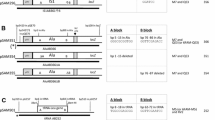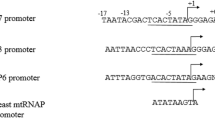Abstract
The bacterial repetitive sequence IS1, is a translocatable DNA segment. The internal region of IS1 acts as a cis-element to stimulate RNA synthesis from the upstream promoter. The product of the bacterial artA gene works with this cis-element to stimulate transcription. Eukaryotic genes for small RNAs and short interspersed repetitive elements (SINEs) have internal promoters, transcribed by RNA polymerase III (RNAP III). RNAP III requires the multisubunit protein factor TFIIIC in transcription initiation. TFIIIC contains the B-block binding subunit which recognizes the internal promoter. Here, I report that the eukaryotic RNAP III promoter-like sequence was found in the cis-element of bacterial IS1. Mutations in the cis-element which affect transcription were present in the RNAP III promoter-like sequence. The RNAP III promoter sequence of Alu, which is a human SINE, was cloned into Escherichia coli, and was shown to stimulate bacterial transcription like the cis-element of IS1. Furthermore, the primary structures of ArtA protein and B-block binding subunits were compared. The amino acid sequence of ArtA appeared to be similar to the N- and C-terminal regions conserved in many B-block binding subunits. Prokaryotes and eukaryotes have been thought to have inherent transcription machineries. The results shown here, however, suggest a new aspect of the evolution of the RNAP III transcription machinery.




Similar content being viewed by others
References
Altschul SF, Madden TL, Schaffer AA, Zhang J, Zhang Z, Miller W, Lipman DJ (1997) Gapped BLAST and PSI-BLAST: a new generation of protein database search programs. Nucl Acids Res 25:3389–3402
Dieci G, Giuliodori S, Catellani M, Percudani R, Ottonello S (2002) Intragenic promoter adaptation and facilitated RNA polymerase III recycling in the transcription of SCR1, the 7SL RNA gene of Saccharomyces cerevisiae. J Biol Chem 277:6903–6914
Fassler JS, Gussin GN (1996) Promoters and basal transcription machinery in eubacteria and eukaryotes: concepts, definitions, and analogies. Methods Enzymol. 273:3–29
Folk WR, Hofstetter H, Birnstiel ML (1982) Some bacterial tRNA genes are transcribed by eukaryotic RNA polymerase III. Nucl Acids Res 10:7153–7162
Galas, DJ, Chandler M (1989) Bacterial insertion sequences. In Berg DE, Howe MM (eds) Mobile DNA. American Society for Microbiology, Washington, DC, pp 109–162
Galli G, Hofstetter H, Birnstiel ML (1981) Two conserved sequence blocks within eukaryotic tRNA genes are major promoter elements. Nature 294:626–631
Geiduschek EP, Tocchini-Valentini GP (1988) Transcription by RNA polymerase III. Annu Rev Biochem 57:873–914
Krayev AS, Markusheva TV, Kramerov DA, Ryskov AP, Skryabin KG, Bayev AA, Georgiev GP (1982) Ubiquitous transposon-like repeats B1 and B2 of the mouse genome: B2 sequencing. Nucl Acids Res 10:7461–7475
Lassar AB, Martin PL, Roeder RG (1983) Transcription of class III genes: formation of preinitiation complexes. Science 222:740–748
Machida C, Machida Y, Ohtsubo E (1984) Both inverted repeat sequences located at the ends of IS1 provide promoter functions. J Mol Biol 177:247–267
Matsutani S (1994) Genetic evidence for IS1 transposition regulated by InsA and the ΔInsA-B′-InsB species, which is generated by translation from two alternative internal initiation sites and frameshifting. J Mol Biol 240:52–65
Matsutani S, (2004) Similarities in transcription factor IIIC subunits that bind to the posterior regions of internal promoters for RNA polymerase III. BMC Evol Biol 4:26
Matsutani S, (2005) The internal sequence of IS1 stimulates RNA synthesis from the IS1 own and exogenous promoters. J Biol Systems 13:313–329
Matsutani S (2006a) Links between repeated sequences. J Biomed Biotechnol 13569:1–3
Matsutani S (2006b) Mechanism of the transcription stimulated by the internal region of IS1 and the product of the artA gene. WSEAS Trans Biol Biomed 4:321–329
Perez-Stable C, Ayres TM, Shen C-KJ (1984) Distinctive sequence organization and functional programming of an Alu repeat promoter. Proc Natl Acad Sci USA 81:5291–5295
Thompson JD, Higgins DG, Gibson TJ (1994) CLUSTAL W: improving the sensitivity of progressive multiple sequence alignment through sequence weighting, position-specific gap penalties and weight matrix choice. Nucl Acids Res 22:4673–4680
Yanisch-Perron C, Vieira J, Messing J (1985) Improved M13 phage cloning vectors and host strains: nucleotide sequences of the M13mp18 and pUC19 vectors. Gene 33:103–119
Weiner AM, Deininger PL, Efstratiadis A (1986) Nonviral retroposons: genes, pseudogenes, and transposable elements generated by the reverse flow of the genetic information. Annu Rev Biochem 55:631–661
Willis IM (1993) RNA polymerase III. Genes, factors and transcription specificity. Eur J Biochem 212:1–11
Wu JH, Ippen-Ihler K (1989) Nucleotide sequence of traQ and adjacent loci in the Escherichia coli K-12 F-plasmid transfer operon. J Bacteriol 171:213–221
Author information
Authors and Affiliations
Corresponding author
Rights and permissions
About this article
Cite this article
Matsutani, S. Possible presence and role of the promoter sequence for eukaryotic RNA polymerase III in bacteria. Genetica 131, 127–134 (2007). https://doi.org/10.1007/s10709-006-9122-5
Received:
Accepted:
Published:
Issue Date:
DOI: https://doi.org/10.1007/s10709-006-9122-5




